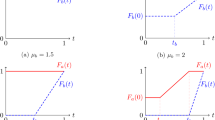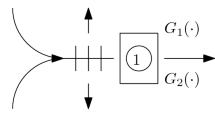Abstract
In personalized queues, information at the level of individuals—customers or servers—affects system dynamics. Such information is becoming increasingly accessible, directly or statistically, as exemplified by personalized/precision medicine (customers) or call center workforce management (servers). In the present work, we take advantage of personalized information about customers, specifically knowledge of their actual (im)patience while waiting to be served. This waiting takes place in a many-server queue that alternates between over- and underloaded periods, hence a fluid view provides a natural modeling framework. The parsimonious fluid view enables us to parameterize and analyze partial information, and consequently calculate and understand the benefits from personalized customer information. We do this by comparing least-patience first (LPF) routing (personalized) against FCFS (relatively info-ignorant). An example of a resulting insight is that LPF can provide significant advantages over FCFS when the durations of overloaded periods are comparable to (im)patience times.






Similar content being viewed by others
References
Aksin, Z., Ata, B., Emadi, S., Su, C.-L.: Structural estimation of callers’ delay sensitivity in call centers. Manag. Sci. 59(12), 2727–2746 (2013)
Altman, E., Jiménez, T., Koole, G.: On the comparison of queueing systems with their fluid limits. Probab. Eng. Inf. Sci. 15(2), 165–178 (2001)
Argon, N., Ziya, S.: Priority assignment under imperfect information on customer type identities. Manuf. Serv. Oper. Manag. 11(4), 674–693 (2009)
Argon, N., Ziya, S., Righter, R.: Scheduling impatient jobs in a clearing system with insights on patient triage in mass casualty incidents. Probab. Eng. Inf. Sci. 22(3), 301–332 (2008)
Asmussen, S.: Applied Probability and Queues, 2nd edn. Springer, New York (2003)
Atar, R., Biswas, A., Kaspi, H.: Fluid limits of \(G/G/1+G\) queues under the non-preemptive earliest-deadline-first discipline. Math. Oper. Res. 40(3), 683–702 (2015)
Bassamboo, A., Randhawa, R.: Using estimated patience levels to optimally schedule customers. Preprint (2013)
Batt, R., Terwiesch, C.: Waiting patiently: an empirical study of queue abandonment in an emergency department. Manag. Sci. 61(1), 39–59 (2015)
Billingsley, P.: Convergence of Probability Measures, 2nd edn. Wiley, New York (1999)
Brown, L., Gans, N., Mandelbaum, A., Sakov, A., Shen, H., Zeltyn, S., Zhao, L.: Statistical analysis of a telephone call center: a queueing-science perspective. J. Am. Stat. Assoc. 100, 36–50 (2005)
Cohen, I., Mandelbaum, A., Zychlinski, N.: Minimizing mortality in a mass casualty event: fluid networks in support of modeling and management. IIE Trans. 46(7), 728–741 (2014)
Decreusefond, L., Moyal, P.: Fluid limit of a heavily loaded EDF queue with impatient customers. Markov Process. Relat. Fields 14(1), 131–158 (2008)
Dertouzos, M.: Control robotics: the procedural control physical processes. In: Proc. IFIP Congress, Stockholm (1974)
Doytchinov, B., Lehoczky, J., Shreve, S.: Real-time queues in heavy traffic with earliest-deadline-first queue discipline. Ann. Appl. Probab. 11(2), 332–378 (2001)
Feigin, P.: Analysis of customer patience in a bank call center. Working Paper (2006)
Gans, N., Liu, N., Mandelbaum, A., Shen, H., Ye, H.: Service times in call centers: agent heterogeneity and learning with some operational consequences. In: Berger, J., Cai, T., Johnstone, I. (eds.) Borrowing Strength: Theory Powering Applications—A Festschrift for Lawrence D. Brown, Collections, vol. 6, pp. 99–123. Institute of Mathematical Statistics, Beachwood (2010)
Garnett, O., Mandelbaum, A., Reiman, M.: Designing a call center with impatient customers. Manuf. Serv. Oper. Manag. 4(3), 208–227 (2002)
Ghebali, R.: Real-time prediction of the probability of abandonment in call centers. Master’s Thesis, Technion—Israel Institute of Technology, Haifa (2012)
Green, L., Soares, J., Giglio, J., Green, R.: Using queueing theory to increase the effectiveness of emergency department provider staffing. Acad. Emerg. Med. 13(1), 61–68 (2006)
Halfin, S., Whitt, W.: Heavy-traffic limits for queues with many exponential servers. Oper. Res. 29(3), 567–588 (1981)
Hong, J., Tan, X., Towsley, D.: A performance analysis of minimum laxity and earliest deadline scheduling in a real-time system. IEEE Trans. Comput. 38(12), 1736–1744 (1989)
Jackson, J.: Some problems in queueing with dynamic priorities. Nav. Res. Log. Q. 7(3), 235–249 (1960)
Jackson, J.: Waiting time distribution for queues with dynamic priorities. Nav. Res. Log. Q. 9(1), 31–36 (1960)
Jackson, J.: Queues with dynamic priority discipline. Manag. Sci. 8(1), 18–34 (1961)
Jiménez, T., Koole, G.: Scaling and comparison of fluid limits of queues applied to call centers with time-varying parameters. OR Spect. 26(3), 413–422 (2004)
Kang, W.: Existence and uniqueness of a fluid model for many-server queues with abandonment. Oper. Res. Lett. 42(6–7), 478–483 (2014)
Kang, W., Pang, G.: Computation and properties of fluid models of time-varying many-server queues with abandonment. Preprint (2013)
Kang, W., Pang, G.: Fluid limit of a multiclass many-server queueing network with abandonment and feedback. Preprint (2013)
Kang, W., Pang, G.: Equivalence of fluid models for \(G_t/GI/N+GI\) queues. Preprint (2014)
Kang, W., Ramanan, K.: Fluid limits of many-server queues with reneging. Ann. Appl. Probab. 20(6), 2204–2260 (2010)
Kaplan, E.: Terror queues. Oper. Res. 58(4), 773–784 (2010)
Kaspi, H., Ramanan, K.: Law of large numbers limits for many-server queues. Ann. Appl. Probab. 21(1), 33–114 (2011)
Kruk, L., Lehoczky, J., Shreve, S.: Accuracy of state space collapse for earliest-deadline-first queues. Ann. Appl. Probab. 16(2), 516–561 (2006)
Kruk, L., Lehoczky, J., Ramanan, K., Shreve, S.: Heavy traffic analysis for EDF queues with reneging. Ann. Appl. Probab. 21(2), 484–545 (2011)
Li, D., Glazebrook, K.: A Bayesian approach to the triage problem with imperfect information. Eur. J. Oper. Res. 215(1), 169–180 (2011)
Liu, Y., Whitt, W.: A network of time-varying many-server fluid queues with customer abandonment. Oper. Res. 59(4), 835–846 (2011)
Liu, Y., Whitt, W.: The \(G_t/GI/s_t+GI\) many-server fluid queue. Queueing Syst. Theory Appl. 71(4), 405–444 (2012)
Liu, Y., Whitt, W.: A many-server fluid limit for the \(G_t/GI/s_t+GI\) queueing model experiencing periods of overloading. Oper. Res. Lett. 40(5), 307–312 (2012)
Mandelbaum, A., Momčilović, P.: Queues with many servers and impatient customers. Math. Oper. Res. 37(1), 41–64 (2012)
Mandelbaum, A., Zeltyn, S.: Data-stories about (im)patient customers in tele-queues. Queueing Syst. Theory Appl. 75(2–4), 115–146 (2013)
Mandelbaum, A., Massey, W., Reiman, M.: Strong approximations for Markovian service networks. Queueing Syst. Theory Appl. 30(1–2), 149–201 (1998)
Merin, O., Ash, N., Levy, G., Schwaber, M., Kreiss, Y.: The Israeli field hospital in Haiti—ethical dilemmas in early disaster response. N. Engl. J. Med. 362(11), e38 (2010)
Mieghem, J.V.: Due date scheduling: asymptotic optimality of generalized longest queue and generalized largest delay rules. Oper. Res. 51(1), 113–122 (2003)
Mistovich, J., Hafen, B., Karren, K.: Prehospital Emergency Care. Prentice Hall Health, Englewood Cliffs (2000)
Moyal, P.: Convex comparison of service disciplines in real-time queues. Oper. Res. Lett. 36(4), 496–499 (2008)
Moyal, P.: On queues with impatience: stability, and the optimality of earliest deadline first. Queueing Syst. Theory Appl. 75(2–4), 211–242 (2013)
Palm, C.: Methods of judging the annoyance caused by congestion. Tele 2, 1–20 (1953)
Pang, G., Whitt, W.: Two-parameter heavy-traffic limits for infinite-server queues. Queueing Syst. Theory Appl. 65(4), 325–364 (2010)
Panwar, S., Towsley, D., Wolf, J.: Optimal scheduling policies for a class of queues with customer deadlines to the beginning of service. J. ACM 35(4), 832–844 (1988)
Reed, J.: The \(G/GI/N\) queue in the Halfin–Whitt regime. Ann. Appl. Probab. 19(6), 2211–2269 (2009)
Saghafian, S., Hopp, W., Oyen, M.V., Desmond, J., Kronick, S.: Patient streaming as a mechanism for improving responsiveness in emergency departments. Oper. Res. 60(5), 1080–1097 (2012)
Saghafian, S., Hopp, W., Oyen, M.V., Desmond, J., Kronick, S.: Complexity-augmented triage: a tool for improving patient safety and operational efficiency. Manuf. Serv. Oper. Manag. 16(3), 329–345 (2014)
Spencer, J., Sudan, M., Xu, K.: Queueing with future information. Ann. Appl. Probab. 24(5), 2091–2142 (2014)
Stoyenko, A., Georgiadis, L.: On optimal lateness and tardiness scheduling in real-time systems. Computing 47(3–4), 215–234 (1992)
Wein, L.: Due-date setting and priority sequencing in a multiclass \(M/G/1\) queue. Manag. Sci. 37(7), 834–850 (1991)
Whitt, W.: Fluid models for multiserver queues with abandonments. Oper. Res. 54(1), 37–54 (2006)
Acknowledgements
The work of A. M. has been partially supported by BSF Grants 2008480 and 2014180, ISF Grants 1357/08 and 1955/15 and by the Technion funds for promotion of research and sponsored research. Some of the research was funded by and carried out while A. M. was visiting the Statistics and Applied Mathematical Sciences Institute (SAMSI) of the NSF; the Department of Statistics and Operations Research (STOR), the University of North Carolina at Chapel Hill; the Department of Information, Operations and Management Sciences (IOMS), Leonard N. Stern School of Business, New York University; and the Department of Statistics, The Wharton School, University of Pennsylvania—the wonderful hospitality of all four institutions is gratefully acknowledged and truly appreciated. The work of P. M. has been partially supported by the NSF Grant CMMI-1362630 and the BSF Grant 2014180. Finally, the authors thank the 2012 SAMSI Working Group on Data-Based Patient Flow in Hospitals, which provided an encouraging forum for our research as it evolved. In particular, Jamol Pender suggested, during a SAMSI meeting, the MPF policy as a benchmark.
Author information
Authors and Affiliations
Corresponding author
Rights and permissions
About this article
Cite this article
Mandelbaum, A., Momčilović, P. Personalized queues: the customer view, via a fluid model of serving least-patient first. Queueing Syst 87, 23–53 (2017). https://doi.org/10.1007/s11134-017-9537-y
Received:
Revised:
Published:
Issue Date:
DOI: https://doi.org/10.1007/s11134-017-9537-y




